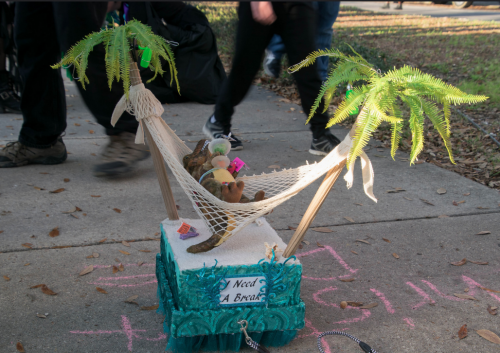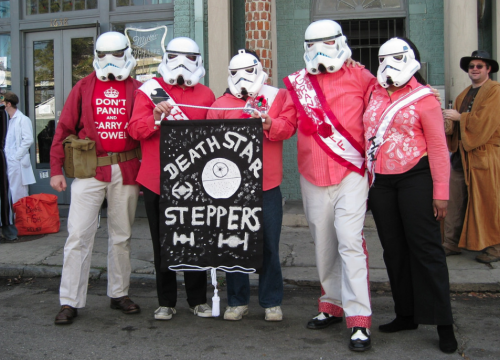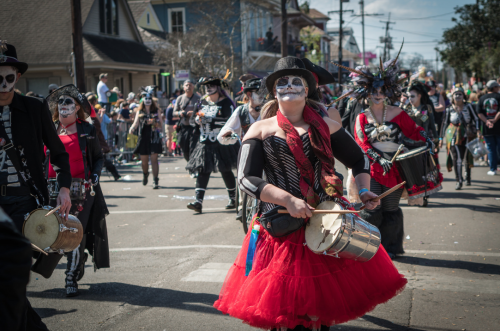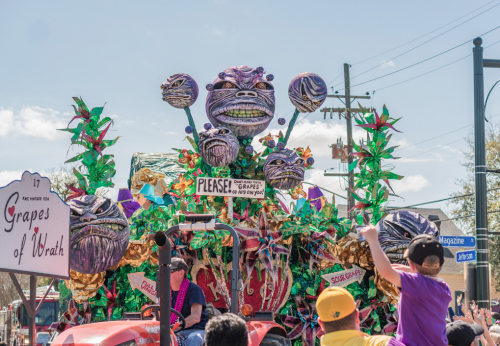The first Mardi Gras parade New Orleans was held in 1856, over 150 years ago. Today there are, by my count, sixty-eight official Mardi Gras parades in New Orleans and the vicinity. No doubt there are many more informal groups. Each is a private organization, typically still called krewes, wholly funded by its members.
In this sense, Mardi Gras in New Orleans is truly a product of locals who choose to play a role in creating its magic every year. That is, unlike other spectacles — like the city of Las Vegas or the Macy’s Thanksgiving Day Parade — Mardi Gras in New Orleans is a non-corporate holiday facilitated, but not put on by, the city or state government. Even in light of it’s oppressive past and present, it is truly one of the most purely generous, creative, and authentic things I have ever had the pleasure to observe.
Understanding why there are so many parades is part of the story.
First, krewes have traditionally been segregated by race and gender. New krewes have formed to enable the participation of excluded groups (Zulu 1909, Iris 1917) or integrate the tradition (e.g., Orpheus 1993).
Krewes have also emerged as commentary on this sort of exclusion. The Krewe of Tucks was started by two white male Loyola students in 1969. They wanted to parade as flambeaux carriers — a nod to the original form of parades in which slaves or free men of color carried flames through the streets to illuminate the floats — but were denied. No white person had ever carried the flambeaux.
Annoyed, they started their own parade aimed at mocking the whole parade tradition. Their king sits on a toilet throne and to this day they TP the city in toilet paper as they parade through the streets.
Other parades simply reflect the unending creativity and ingenuity of the people of New Orleans. Responding to the increasing grandeur of Mardi Gras floats over time, ‘tit Rex (as in “petite”) decided to go miniature. Every year, members build tiny floats on a theme and parade them through the Marigny neighborhood. The theme in 2013? “Wee the people.”
‘tit Rex:
Flickr Creative Commons, Chuck Robinson
Not enough sci-fi in the super krewes? There is the Krewe of Chewbacchus — riffing off the famous Krewe of Bacchus. These BacchanAliens offer an intergalactic parade, tripping down the streets of New Orleans with a Bar-2-D2 and other creations.
Chewbacchus:
Flickr Creative Commons, C. Paul Counts
Other parades came about to serve neighborhoods or individuals who were isolated geographically or by mobility. The Krewe of Thoth (1948) was founded in order to offer a parade to the residents of 14 institutions, off the typical parade route, that served people with illnesses or disabilities, bringing Mardi Gras to those who couldn’t come to it. Other krewes emerged simply to serve neighborhoods that tourists rarely visit.
Images: Flickr Creative Commons, James Cage
So there are the stories of a few Mardi Gras krewes, helping to explain the bounty of parades available to enjoy in New Orleans. If you have any favorites, please add them in the comments!
Lisa Wade, PhD is an Associate Professor at Tulane University. She is the author of American Hookup, a book about college sexual culture; a textbook about gender; and a forthcoming introductory text: Terrible Magnificent Sociology. You can follow her on Twitter and Instagram.




Comments 6
Sara Davis — February 17, 2015
Very cool to read about Thoth! When I lived in NOLA, my first apartment was across the street from a senior care center, whose residents were wheeled out to see the Thoth parade. It was a very family-centric neighborhood, so there were a lot of kids hanging around or sitting in special ladders that had seats at the top. Parents drank and chitchatted with other parents. My roommates and I carried our couch outside and sat on our lawn eating grilled cheeses.
This is my favorite parade to tell people about, because for me it captures the spirit of Mardi Gras--playful, friendly, inclusive. Definitely not all about out-of-towners going nuts.
The Flambeaux: A History of Race, Gender, and Fire on Mardi Gras | A Nerd's Guide to New Orleans — February 18, 2015
[…] first white men to carry the flambeaux appeared in a parade in 1969, something I’ll talk about tomorrow. Meanwhile, the first ever all-female flambeaux troupe, the glambeaux, debuted in 2014 (images […]
Bill R — February 18, 2015
I would note that this "non-corporate" holiday is made possible, in fact much of the survival of the city as we know it is literally brought to you by NOLA's #1 industry: tourism...which is very much a business endeavor.
Tourists also spend most of their dollars in the service sector and in local, small businesses, which means that a tourist's dollar is circulated inside the local economy several times.
Without this vital business--an industry of hotel corporate giants and small Hurricane street carts--there would be very few parades to marvel at.
TSP’s Weekly Roundup: Feb. 20, 2015 - Treat Them Better — February 20, 2015
[…] Sociological Images goes to Mardis Gras! […]
#2. Intergalactic Krewe of Chewbacchus: How to Keep it Local in Space – 2017 Mardi Gras Drinking Locally Guide — February 18, 2017
[…] Pictured: Bar-2 D2 Float from a previous Chewbacchus parade (Source) […]
Bennet — May 13, 2025
I was looking for this thanks alot!